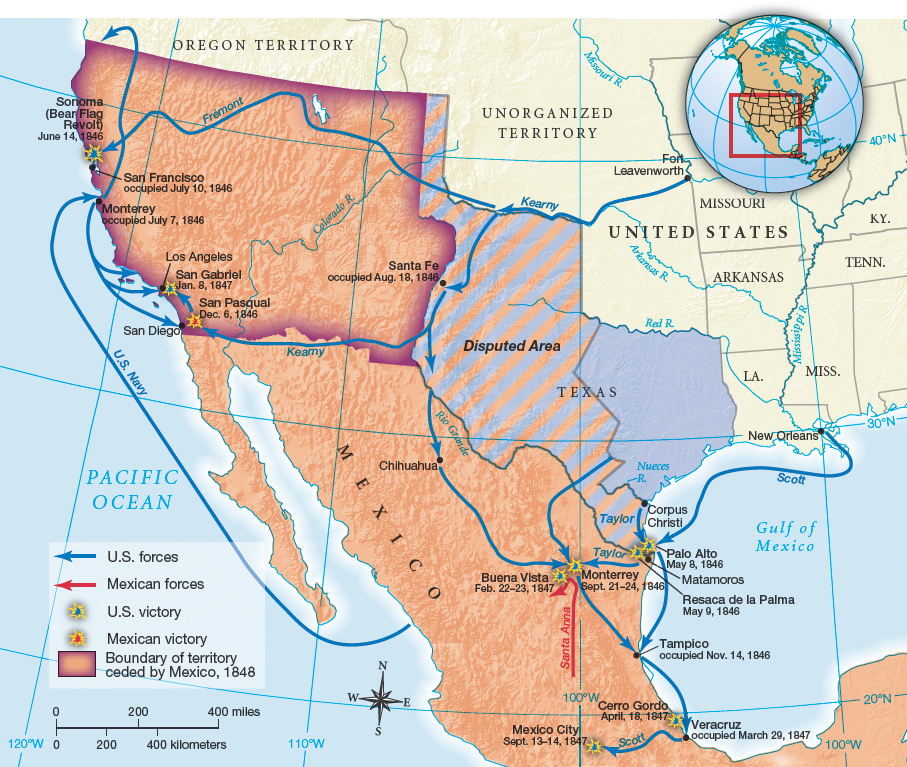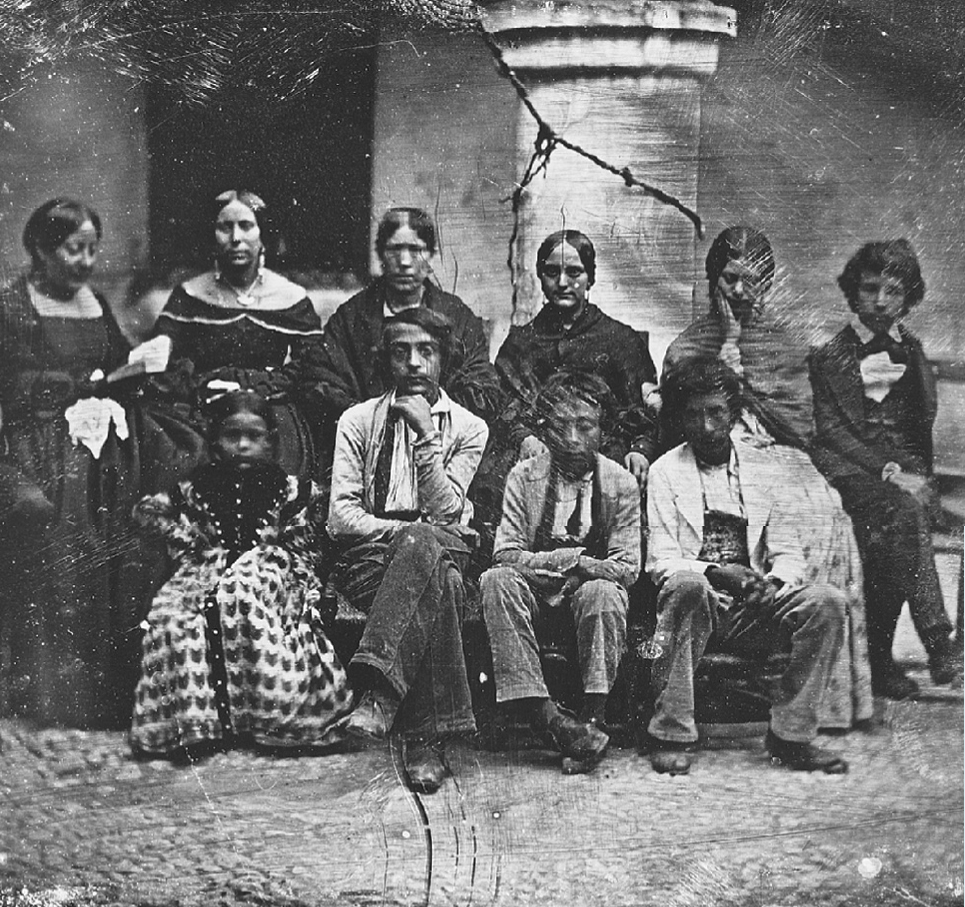The Mexican-American War, 1846–1848.
Printed Page 320 Chapter Chronology
The Mexican-American War, 1846–1848. From the day he entered the White House, Polk craved Mexico's remaining northern provinces: California and New Mexico, land that today makes up California, Nevada, Utah, most of New Mexico and Arizona, and parts of Wyoming and Colorado. Since the 1830s, Comanches, Kiowas, Apaches, and others had attacked Mexican ranches and towns, killing thousands, and the Polk administration invoked Mexico's inability to control its northern provinces to denigrate its claims to them. Polk hoped to buy the territory, but when the Mexicans refused to sell, he concluded that military force would be needed to realize the United States' manifest destiny.
Polk ordered General Zachary Taylor to march his 4,000-man army 150 miles south from its position on the Nueces River, the southern boundary of Texas according to the Mexicans, to the banks of the Rio Grande, the boundary claimed by Texans (Map 12.4). Viewing the American advance as aggression, Mexican cavalry on April 25, 1846, attacked a party of American soldiers, killing or wounding sixteen and capturing the rest.

On May 11, the president told Congress, "Mexico has passed the boundary of the United States, has invaded our territory, and shed American blood upon American soil." Thus "war exists, and, notwithstanding all our efforts to avoid it, exists by the act of Mexico herself." Congress passed a declaration of war and began raising an army. The U.S. Army was pitifully small, only 8,600 soldiers. Faced with the nation's first foreign war, against a Mexican army that numbered more than 30,000, Polk called for volunteers. Eventually, more than 112,000 white Americans (40 percent of whom were immigrants; blacks were banned) joined the army to fight in Mexico.
Despite the flood of volunteers, the war divided the nation. Northern Whigs in particular condemned the war. The Massachusetts legislature claimed that the war was being fought for the "triple object of extending slavery, of strengthening the slave power, and of obtaining control of the free states." On January 12, 1848, a gangly freshman Whig representative from Illinois rose in the House of Representatives. Before Abraham Lincoln sat down, he had questioned Polk's intelligence, honesty, and sanity. The president ignored the upstart representative, but antislavery, antiwar Whigs kept up the attack throughout the conflict.
President Polk expected a short war in which U.S. armies would occupy Mexico's northern provinces and defeat the Mexican army in a decisive battle or two, after which Mexico would sue for peace and the United States would keep the territory its armies occupied.
At first, Polk's strategy seemed to work. In May 1846, Zachary Taylor's troops drove south from the Rio Grande and routed the Mexican army, first at Palo Alto, then at Resaca de la Palma (see Map 12.4). "Old Rough and Ready," as Taylor was affectionately known among his adoring troops, became an instant war hero. Polk rewarded Taylor for his victories by making him commander of the Mexican campaign.
A second prong of the campaign centered on Colonel Stephen Watts Kearny, who led a 1,700-man army from Missouri into New Mexico. Without firing a shot, U.S. forces took Santa Fe in August 1846. Kearny then marched to San Diego, where he encountered a major Mexican rebellion against American rule. In January 1847, after several clashes and severe losses, U.S. forces occupied Los Angeles. California and New Mexico were in American hands.
By then, Taylor had driven deep into the interior of Mexico. In September 1846, he had taken the city of Monterrey. Taylor then pushed his 5,000 troops southwest, where the Mexican hero of the Alamo, General Antonio López de Santa Anna, was concentrating an army of 21,000. On February 23, 1847, Santa Anna's troops attacked Taylor at Buena Vista. The Americans won the day but suffered heavy casualties. The Mexicans suffered even greater losses (some 3,400 dead, wounded, and missing, compared with 650 Americans). During the night, Santa Anna withdrew his battered army.

The series of uninterrupted victories in northern Mexico fed the American troops' sense of invincibility. "No American force has ever thought of being defeated by any amount of Mexican troops," one soldier declared. The Americans worried about other hazards, however. "I can assure you that fighting is the least dangerous & arduous part of a soldier's life," one young man declared. Letters home told of torturous marches across arid wastes alive with tarantulas, scorpions, and rattlesnakes. Others recounted dysentery, malaria, smallpox, cholera, and yellow fever. Of the 13,000 American soldiers who died (some 50,000 Mexicans perished), fewer than 2,000 fell to Mexican bullets and shells. Disease killed most of the others. Medicine was so primitive that, as one Tennessee man observed, "nearly all who take sick die."